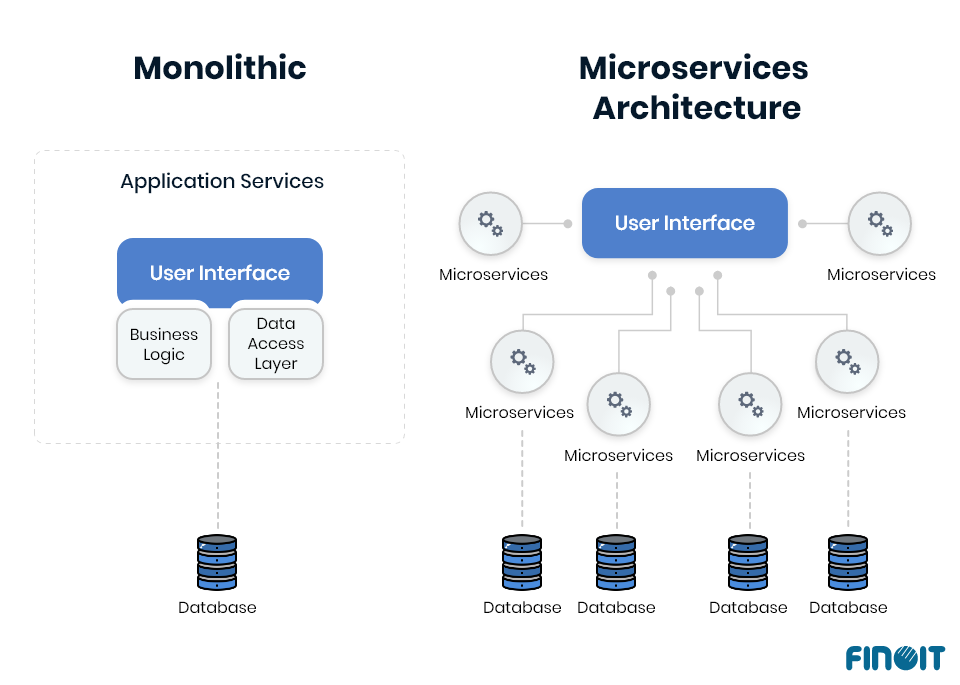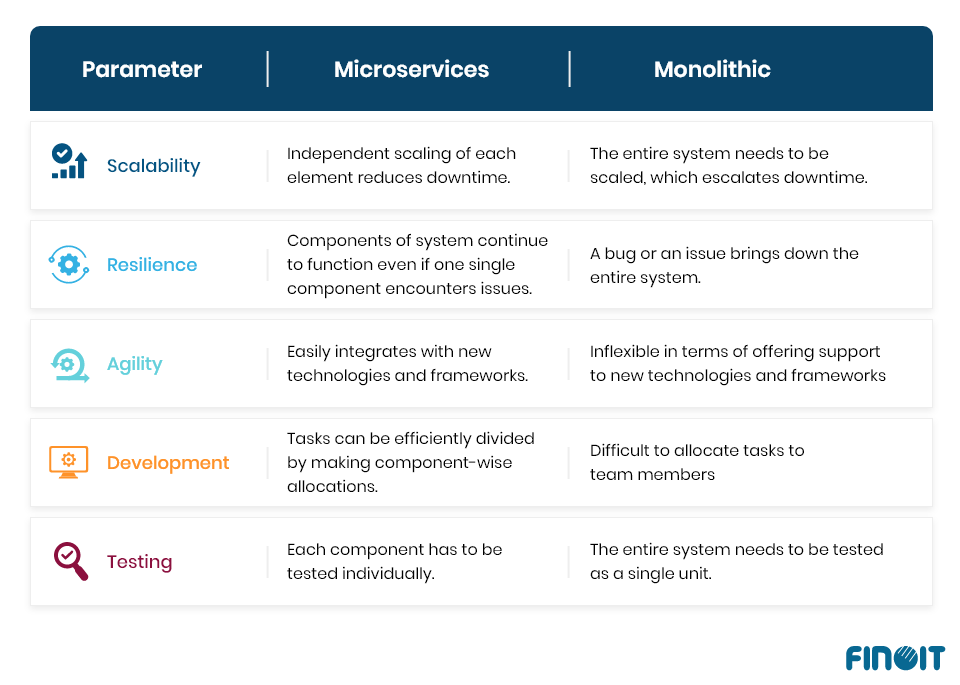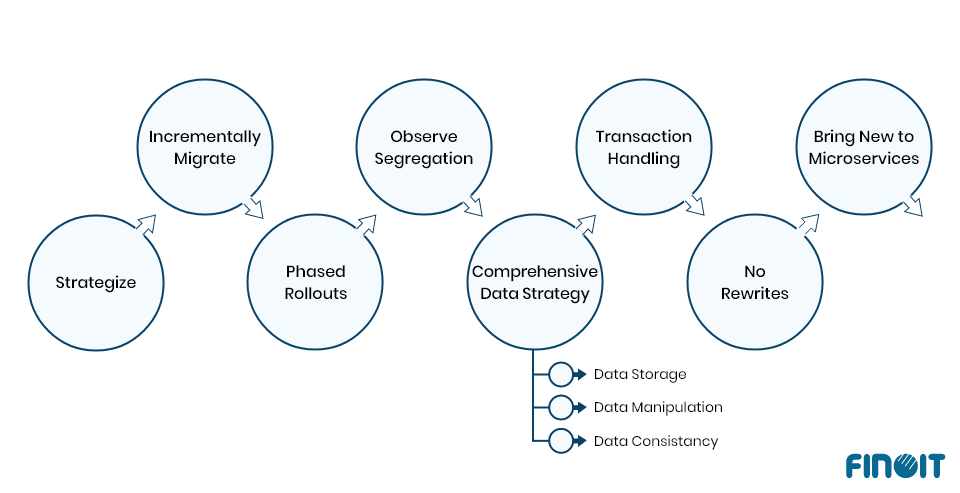Achieving Enterprise Agility and Scalability With Microservices

Microservices architectures underpin most successful software delivery pipelines today. Leveraging them helps you secure long-term business and technological advantages, as we discuss here.
“Any service, at any granularity, can be exposed,” were the words of Dr. Peter Rodgers, while delivering a presentation on cloud computing in 2005. It was here that he used the term Micro-Web-Services, which he said can “improve simplicity and provide radical flexibility” in SOA (service-oriented architectures).
Today, the idea of microservices has taken the enterprise world by storm. Dealing with copious amounts of data with cumbersome monolithic architecture has become unmanageable, especially when the volume and scale of businesses are rising continually. Technological blockages are preventing them to scale technically at the speed at which the business is growing.
Thus, businesses want to get out with the old by embracing microservices architecture, which offers both business and developer benefits.
Microservices have emerged as a dependable solution to scale, speed up, and optimize software delivery. Rising business demands and expectations are acting as a catalyst for their adoption.
Though microservices offer many potential benefits, which could significantly improve operational and economic results, it is never without a good strategy.
Let’s proceed to understand more about microservices, and the roadmap enterprises need to follow for securing advantages associated with them. However, before we take you to this, let’s understand the problems with monolithic architecture.
Monolithic-An infeasible proposition
Working with monolithic architecture has created multiple roadblocks while building applications. This realization is being caused by various issues, facing businesses, which we look at here. Let’s analyze them to understand why monolithic is an infeasible approach to building and scaling software systems.
Lack of scope
Monolithic systems are highly interconnected. Features hence frequently interact with numerous system components and invariably come with side effects. There is no physical division between various components of the systems; monolithic applications are constructed and deployed as a unified unit.
As a result, it is impossible to ensure that every new release will only have an impact on those locations. Even with robust testing procedures such as regression testing, there’s always a possibility that change isolation cannot be facilitated.
Overspending
Despite being the most common style of architecture today, the monolithic method becomes a bottleneck in sophisticated, large-scale systems. As the system’s features and complexity increase, lengthier development and quality assurance cycles are needed.
You must rebuild, execute the full testing cycle, and deploy the entire monolithic once more in order to add a new feature or even make minor modifications to a single component. Monolithic application updates are therefore cumbersome and time-consuming, which is another barrier to more rapid release cycles.
Rigidity
Scaling a monolithic architecture’s logical components is challenging and consumes many resources. Most of the time, the only way to scale a monolithic system is to run it in several instances, which increases the amount of memory and processing resources needed. Consider the scenario where you need to boost the website’s throughput – here, either you need to deploy multiple instances of the entire program and set up load balancers or purchase a virtual machine with higher processing power.
You may not be able to address the issue, even after following these steps. Even then, the problem might not necessarily be resolved. Database locking difficulties could result from the scaling issue, therefore adding additional instances of the monolithic can worsen the situation further.
Over-commitment
For the sake of interoperability, layers of monolithic architecture are typically designed using the same technology and are tightly coupled in-process calls. You effectively deepen your commitment to the current technology stack with each system update.
Developers and architects find it more difficult to switch to or try out other technological stacks. However, they are only less able to leverage new technologies. Being over-committed to a technological framework limits your ability to compete on an even playing field.
The big absence
Regarding our monolithic program, a modification in the Orders module may have an impact on the Stock module, and so forth. Such a situation is the outcome of the absence of modularity. This also implies that we are unable to use a module’s features in another module. The code is not broken up into reusable, structured chunks that might save effort and time. Because the code modules are not divided, there is no common code to use.
The Effects
Hampering the technological performance and down the line, the business performance, the resultant effects of continuing with monolithic architecture are:
The failed promise
With monolithic architecture, it may be argued that the implementation is never fully finished. The reason is that for most enterprises, committing to meeting customer demands and innovating constantly is a big challenge.
As we saw, the difficulty lies in the fact that continuing implementations, whether it’s the release of auxiliary components or an upgrade to the most recent platform version to gain access to new features and functionalities, operations are costly and time-consuming.
Discontentment
Today, when businesses are adopting customer-centric strategies, customer behavior and demands drive every change, and quickly satisfying these needs is a competitive differentiation.
Customer experience improvements on monolithic platforms are conceivable, but they take time as the architecture cannot accommodate a business’s unique use cases, frequently as a result of a misalignment between complicated requirements and a lack of capability. This can have negative implications on the customer experience, leading to dissatisfaction amongst clients and their end users who are using the applications.
What are Microservices?
Wikipedia defines Microservices as an architectural pattern that arranges an application as a collection of loosely-coupled, fine-grained services, communicating through lightweight protocols.
It would be no surprise to be nonplussed at the mere technical concepts that these definitions compose. Let’s thus decompose this definition to understand the idea the components convey.
- Loosely-coupled: There’s a weak association among components of a system.
Implication: Enterprises don’t have to concentrate their resources working on all components, rather they just need to deal with a component(s) where issues have occurred while other components continue to perform their usual function.
- Fine-grained: System is subdivided into smaller individual code units.
Implication: Data transfer takes place at a supersonic speed as the frequency of data transfer improves. This remarkably improves synchronization and communication between system components.
- Lightweight protocols: Communication protocols that are optimized to reduce complexity in communication between system components.
Implication: Based on simple algorithms and hash functions, these protocols lighten the pressure on communication channels by leaving out non-essential data. Its use thus allows businesses to achieve flexibility and scalability.
Having got a fair know-how of the components, let’s understand Microservices again. This time from the viewpoint of Martin Flower, a leading exponent of the concept. He defines Microservices as “a Microservices architecture is a way of designing software applications as suites of independently deployable services.”
So, finally, we can conclude that microservices are an architectural approach where a software system can be viewed as a combination of components. The fact that these components can be managed by separate teams accelerates development and the ability to add new features.
Attributes of microservices
Each microservices architecture is characterized by a set of its own attributes. However, commonly, we can expect microservices to possess the following characteristics.
Autonomy
In a microservices architecture, each component service can be created, deployed, run, and scaled independently of the other services. Services are not required to exchange any of their implementation or source code with other services. Individual component communication takes place through clearly specified APIs.
Organization
The value of microservices can be judged from the fact that they are organized around business value. Such services require a full-stack software solution for that industry, including user interface, persistent storage, and external partnerships. As a result, the teams are cross-functional and comprise the entire spectrum of expertise needed for development, including user experience and project management.
Smartness
Microservice-based applications strive to be as decoupled and cohesive as feasible; they are responsible for their own logic receiving requests, applying logic as necessary, and then returning a response. Instead of using complicated protocols like BPEL or WS-Choreography or orchestration by a central tool, these are choreographed using straightforward REST (Representational State Transfer) protocols. The ideas and protocols upon which the internet is based are used by microservice teams. It takes very little work on the part of developers to cache frequently used resources.
Decentralization
Microservices decentralize data storage decisions in addition to those about conceptual models. Managing data in a decentralized way is one of the most crucial characteristics of microservices. While organizations frequently choose a single database across a variety of apps, monolithic applications frequently prefer a single logical database.

Dynamic Design
Microservices offer evolutionary design. Each service decomposition serves as a tool to render changes to applications. So, making frequent and controlled changes to applications is possible with microservices. The most important thing here is that change control does not always equate to change reduction. Each time there is a need to disintegrate an application into its individual components, developers can do this with ease.
Failure tolerance
Real-time application monitoring is highly prioritized by microservice applications, which look at both architectural components and business-relevant metrics. When something goes wrong, semantic monitoring can act as an early warning system, prompting development teams to look into it further. Microservices act as per the given context, facilitating even coordination accordingly. Overall, this emergent behavior of microservices makes the system tolerant of failures.
Agility and Resilience
With microservices, teams are empowered to respond quickly within a defined, constrained setting. Cycle times for development are shortened. The resilience of an application to failure is increased through service independence. A monolithic architecture makes it possible for the failure of one component to bring the entire program down. So, when encountering a failure, applications based on microservices architecture degrade the functionality and prevent themselves from crashing completely.
Reusability
Software that has been broken down into manageable, well-defined modules allows teams to use its functionalities in a variety of ways. A service created for a certain purpose can serve as the foundation for another functionality. So, basically, software developers don’t have to begin writing the code from scratch for adding new features to an application.

What entices enterprises to go for Microservices?
Yes, the business as well as operational benefits that microservices provide, is enticing many organizations to move from monolithic to microservices architecture. The reasons compelling this move are:
- A microservice can be upgraded or replaced without affecting the other microservices that collectively make up the software application.
- Microservices are often owned by a small, knowledgeable team and are structured around business capabilities.
- Microservices helps apply DevOps approaches, and since these procedures don’t include the entire application, they are simpler to test, follow, and maintain.
- Instead of being constrained to a certain technical framework to design and use microservices, organizations can grow their technology stack by adhering to fundamental principles.
- Each microservice follows standard principles and a common protocol for easy consumption of data and better communication between components.
Transitioning from monolithic to microservices
Sam Newman, a technology consultant and a microservices researcher notes,
“You’re implementing microservices to achieve something. What is it you’re actually trying to achieve? I find many can’t give me a clear articulation of why they’re doing microservices. It starts with having a really clear vision of what it is you’re trying to achieve. Then you can say, is microservices the right approach for this? Are we using microservices in the right way?”
Undeniably, the foremost step to initiate before moving from a monolithic to a microservices architecture is to address a couple of these basic but important questions. The answers will have you ready for achieving long-term resilience with microservices.
When you have a clear understanding of how microservices can benefit your project and how it aligns with your strategic goals, you will get the direction to pursue the right course of action. However, you are not done, as comprehending challenges that stand in the way of microservices adoption is equally vital. Some of the common challenges include:
- Implementing microservices requires developing expertise in specialized frameworks and tools.
- Your monolithic systems might be supporting mission-critical processes and so you will have to take a cautious approach to disintegrate them.
- Developing, orchestrating, and managing autonomous services comes with many complexities.
- Even if you want to observe the design for failure principle, ill-implementing microservices can cascade failures.
- When shifting to microservices you need to pave a way for an immaculate mechanism to manage multiple versions that would be coexisting simultaneously.
- You need to set-up a DevOps process prior to embarking on the microservices journey.
- Considering the distributed nature of microservices, the most appropriate approach to handle distributed transactions has to be identified.
Despite these formidable challenges, enterprises can easily implement microservices for long-term technical and business advantages if they have access to the right approach, which we look at here.
Roadmap to implementing Microservices?
Discussed here is a generic approach to implementing microservices that will allow you to swiftly move from monolithic to microservices architecture.
Strategize
Use domain-driven design principles to combine domain knowledge with technical skills so as to come up with an individual strategy for each application in the system.
Incrementally migrate
Adopt a piecemeal approach by starting with one or two microservices rather than disintegrating the entire monolithic architecture. Begin by operating microservices alongside monolithic applications, till you achieve a fully microservices-enabled architecture.
Phased rollouts
Gives you the power to build fully-tested services, which work as per the business’s expectations, thereby speeding up the rollouts.
Observe segregation
Separate backend and frontend tiers and use lightweight protocols such as REST to make them communicate with each other. This will allow you to loosely couple them and scale the services, as each tier being separate would be independently scalable.
Comprehensive Data Strategy
Microservices bring forward multiple challenges to managing, handling, and maintaining data. Each aspect of data, including data privacy, querying, and reporting, brings its own set of challenges. So, the data strategy would comprise multiple tactics, as we look here.
Data storage
Consider desired throughput and scalability, and application complexity, before you go for a data store.
Data Manipulation
Identify which data manipulation strategy would work the best for your services. You can either choose CRUD (Create, Read, Update, and Delete) with the same data model for write and read operations or CQRS (Command and Query responsibility) with separate data models for write and read operations.
Data Consistency
Consider your business use case before finalizing the consistency model. Most businesses choose to go with the “eventual consistency” model where the throughput of the system is the most critical performance factor.
Transaction handling
Build transactional business applications and the best way to achieve this is by using domain-driven design so that business and technical capabilities are best combined.
No Rewrites
Make an effort to ensure that you avoid every chance of rewriting codes from scratch unless and until that is absolutely necessary. The best way is always to reuse the code by retrofitting it.
Bring new to microservices
Bring in new functionalities straightaway in microservices instead of making them a part of the monolithic application. This will progressively mature your microservices architecture and reduce your dependence on the monolithic application.

It’s more than technological upgradation
Being microservices-enabled might seem to be a journey to becoming technically superior; however, not without cultural changes and good governance.
In order to transition to using microservices, the majority of the work must be done in advance. At the micro level, it means making sure there are enough developers on staff with the necessary skill sets, working in a DevOps practice with appropriately structured teams.
You thus need to be ready to bring in new team members with cutting-edge technical skills and equip your existing team members to bear the brunt while the process of transition goes on. Change is thus a progressive process and will demand patient efforts from each stakeholder in the process.
Governance is significant while implementing microservices, as it commonly is in digital transformation. Build rules to ensure consistency in how various teams address microservices and define individual accountability towards their tasks. This prevents the costly and wasteful effort that would be duplicated and could have an influence on interoperability.
By establishing rules and standards before bringing in microservices, governance helps prevent errors, reduce costs, and assure an easy transition to a successful microservices ecosystem.
Embracing microservices the right way
“The meaning of microservices architecture has evolved over the past decade. People often think it’s about size, but it’s more important to design for replaceability,” founded the podcast by InfoQ, featuring Chris Richardson, James Lewis, and Katie Gamanji, three prominent software development and architecture experts.
As we saw, along with a strong inclination towards embracing the latest technologies and digital savviness, implementing microservices calls for a strong cultural shift. Understanding your business problem is more important than just harboring the intention to embrace microservices.
You first need to build a strong foundation for erecting the setup for microservices architecture, as microservices won’t be of any help to you in addressing the slowness of your software delivery process. As a result, you will first have to improve the maturity of your delivery process. Revolutionize each step, right from designing, coding, and maintenance, so that the overall maturity of the process enhances automatically.


